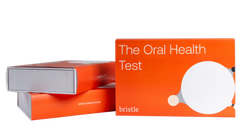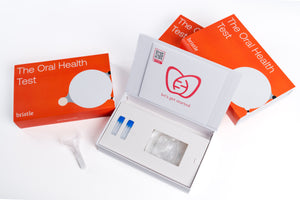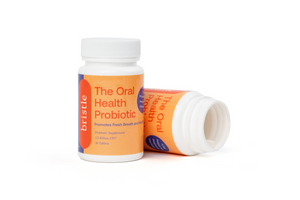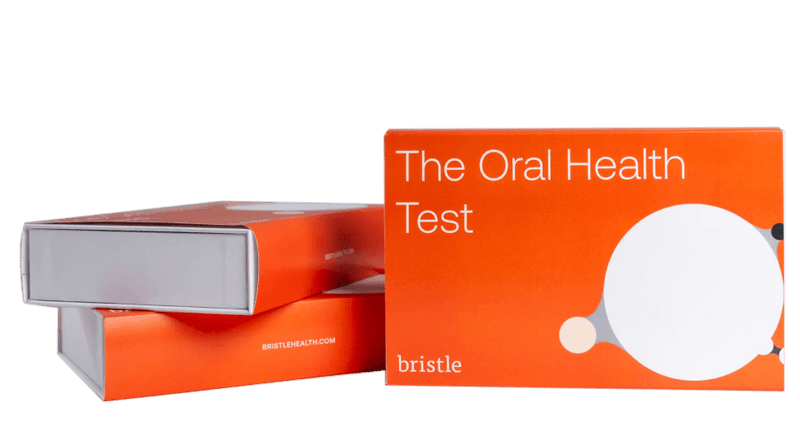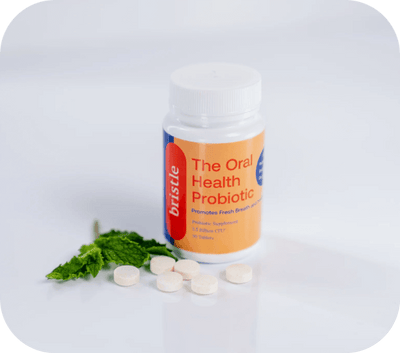At-home Test Reveals Root Causes of Tooth Decay, Gum Disease, and More

Finding Genius Podcast
21 Minutes
Intro:
Forget frequently asked questions, common sense, common knowledge or Google. How about advice from a real genius? 95% of people in any profession are good enough to be qualified and licensed. 5%, go above and beyond. They become very good at what they do. But only 0.1% are real geniuses. Richard Jacobs has made it his life's mission to find them for you. He hunts down and interviews geniuses in every field. Sleep science, cancer, stem cells, ketogenic diets, and more. Here come the geniuses. This is the Finding Genius Podcast with Richard Jacobs.
Richard Jacobs:
Hello, this is Richard Jacobs with the Finding Genius Podcast, now part of a Finding Genius Foundation.
Richard Jacobs:
Today I have Danny Grannick. He's the CEO and co-founder of Bristle. It's an at home oral microbiome test. So Danny, thank you for coming.
Danny Grannick:
Yeah. Thanks for having me.
Richard Jacobs:
Tell me about your background. How did you get into the world of microbiome and into Bristle?
Danny Grannick:
Yeah, so my background was originally in biochemistry on the physical side, chemistry side of things. So I was much more math oriented. Spent about three and a half years in the lab in undergrad. And as I was going through research, I found myself a lot more interested in the applications and the commercialization of what I was working on than necessarily the experiments themselves. And that pushed me towards the commercial side of biotechnology. I grew up in San Diego, so there was always that environment. And coming out of school, I ended up working at Illumina, which is the well recognized behemoth in genomics and sequencing. So that really exposed me to, basically, every application for genomics under the sun. Everything from oncology to NIPT to rare undiagnosed genetic disease.
Richard Jacobs:
Were you running sequencing machines to look for SNPs and other stuff?
Danny Grannick:
Exactly. Yeah. So it's genetic sequencing technology, basically the underlying technology that the majority of genomics companies use to generate the raw data.
Richard Jacobs:
OK. So you were working for them and then what happened?
Danny Grannick:
Yeah, it was a serendipitous series of events. I ended up moving to San Francisco, lived there for the last four years and my, now, co-founder, Brian, had moved up around the same time. We were at a pitch competition at UCSF and had heard a few pitches around gut microbiome sequencing. And we had worked with a variety of those kinds of companies. And we were sitting there thinking, how many of these companies are going to pop up.
Danny Grannick:
And Brian, by chance is, I would say, this cliche person where he's religious about oral hygiene. And every time he goes to the dentist, he inevitably has a cavity. And he happened to have a dental appointment the next day. And as he was talking about that, it really just clicked between the two of us that we could retool and repurpose the microbiome sequencing applications that we'd become really familiar with and instead look at oral health and care. And that set us off on what ended up being, I think, a year to a year and a half of customer discovery. And then we started the company officially last October.
Richard Jacobs:
Okay. And what's the premise to the company? What's the goal?
Danny Grannick:
Bristle helps people understand and improve their oral health. So we take a user's saliva and we analyze it, looking at the oral microbiome, the makeup of bacteria, fungi and viruses that reside in the oral cavity. And we have developed signatures related to oral health status. So we take this really complex genomic data and we boil it down into some very simple scores to help people understand their oral health and incorporate clinical and behavioral risk factors related to cavities, gum disease and bad breath. And that allows us to then provide them with personalized recommendations around things like diet, hygiene, and oral care products. And the really big innovation here is the dental industry has revolved around using physical symptoms as a method for diagnosing disease.
Danny Grannick:
So we go to the dentist and we get an x-ray or we get an observational screening and they're looking for the presence or the severity of tooth decay, or the amount of blood coming from your gums. But using the oral microbiome, we can really look at the causal pathogenic bacteria that are driving the disease and detected a lot earlier, oftentimes before visible symptoms have manifested.
Richard Jacobs:
So what are you looking for, the presence of certain species or what does the test do?
Danny Grannick:
Yeah, I think there's over 700 characterized species of bacteria that are present in the oral microbiome. On average, we each have around 200. So our assay characterizes all 200 of those. And a subset have been causally related to the onset of cavities and periodontal disease. Or assay detects those bacteria, if they're in your oral cavity, their relative abundance. And then we use that to convey oral health status for those indications.
Richard Jacobs:
Yeah. But there's many different microbiomes in the mouth. Under the tongue maybe different from outside of the lower teeth or the roof or the cheek. So how do you know when someone's, let's say, doing a swab or a spit test that you're getting the representative of microbiomes and you know the constituency of each?
Danny Grannick:
Yeah, we did a lot of clinical testing in our lab to develop the assays. We've shown that getting a saliva sample, especially a direct saliva sample compared to something like an oral rinse gives a really good baseline for the comprehensive oral microbiome. We're not accurate enough to say, you have this abundance of pathogenic bacteria around this tooth. But because our assays are sensitive and we're focused on really that primary oral care piece, we can detect a lot of these pathogenic bacteria again before they've had a chance to cause damage and implement some preventive measures from there.
Richard Jacobs:
But again, which of the microbiomes in the mouth are you sampling? What have you found?
Danny Grannick:
Well, when you do a saliva sample, you're really pulling from a bunch of different environments. So we get a mixture. It's a generalized representation of the oral microbiome of each individual environment.
Richard Jacobs:
Well, you're having someone use like a mouthwash or something as a carrier, switching it around and then spitting? Or they're just spitting on their own?
Danny Grannick:
No. It's a raw saliva sample.
Richard Jacobs:
Mouthwash might help.
Danny Grannick:
Yeah. We found that the raw saliva sample actually gives a bit of representation that a mouthwash.
Richard Jacobs:
Okay. And [inaudible 00:08:21] represents any of the microbiomes in the mouth or does it-
Danny Grannick:
It's a general sampling of the-
Richard Jacobs:
Each of them equally?
Danny Grannick:
Yeah. It's a general sampling of the oral microbiomes. So it's not going to be specific to any particular environment. But there are microbes that are more suited and native to certain environments in the mouth. So we're going to be building in those kinds localized insights in the assay. But again, it's not a specific swab around a single tooth. It's a general picture of the status of your oral microbiome and oral health.
Richard Jacobs:
So what are you looking for and what does it tell you?
Danny Grannick:
Again, we have a pretty comprehensive assay. So in terms of generating the species of bacteria, we're not preselecting or screening for any bacteria in particular. But in the dataset, we're looking for specific bacteria that are causally related to the onset of cavities and periodontal disease and halitosis. So bacteria that produce certain compounds, sulfur based compounds that cause a bad odor. And we get down to the species level, we take the relative abundance and that correlates to a potential risk for those indications. So in the case of cavities causing bacteria, these are species of bacteria that are acidogenic. Based on the relative abundance in specific species that you have, you may be more at risk for the onset of a cavity, whereas somebody with less abundance of those species or no species at all, ideally, is that at less risk.
Richard Jacobs:
So is this done before someone eats or after? What are the things that can confound the sampling?
Danny Grannick:
Yeah. So food can confound it. We advise our users, the best time to do it is really first thing in the morning before you've brushed your teeth or eaten anything. So we advise them to just put it next to their nightstand and do it first thing when they wake up. Otherwise, as long as you stop eating 30 minutes... Eating, drinking, smoking, anything like that could confound the sample 30 minutes before providing your saliva. We found that the results are pretty consistent.
Richard Jacobs:
To give your body the important immune support it needs so you can fill your absolute best, get your gut in order with Just Thrive Probiotic. Very nice of them, they're offering 15% off for listeners all across their website. So go to justthrivehealth.com and put in the code genius15. And you can take advantage of incredible savings and learn more about their products.
Richard Jacobs:
All right. And again, what are you looking for? So when someone gets a test result, what do you tell them to do and how and why?
Danny Grannick:
Yeah, so the test results basically break down all of the bacteria that are related to cavities and the relative abundance, periodontal disease and halitosis. And then we'll match those with respective recommendations around dietary changes, oral hygiene changes as well as specific oral care products to mitigate the onset of those pathogenic bacteria. So, for somebody who might be extremely high risk for periodontal disease, we'll deliver different recommendations than somebody who is high risk for cavities. And for the latter, we might recommend, depending on what their lifestyle choices are, reducing sugar intake or acidic food intake, using xylitol chewing gum after meals, things like that.
Richard Jacobs:
I heard a trade off between someone that's predisposed to cavities versus someone that builds up a lot of tartar. What's your observation? Are they trade offs, and can you send someone in the wrong direction in terms of their oral microbiome health, if they're skewed in some way to begin with?
Danny Grannick:
In terms of tartar buildup, what are you describing as a trade off there?
Richard Jacobs:
Well, I've heard that people that tend to get cavities don't tend to have as much tarter buildup. And people that rarely or never get cavities tend to, for some reason, get a lot more calcification around the bottoms of teeth. So I've heard that there's a trade off. I don't know if you've observed that and if it shows up in the microbiome constituents.
Danny Grannick:
Yeah. I haven't observed the trade off. I mean, I think that, one thing that we have seen, and this maybe related to what you read is, periodontal disease causing bacteria are some of the main plaque inducers. And obviously, plaque enhardening to calculus or tarter over time. And there is a battle for real estate in the oral microbiome between those various pathogenic bacteria. So it may be possible that somebody who has reduced tartar may have higher abundance of cavities causing bacteria because they're taking up more real estate. Versus somebody who has a lot of plaque buildup. And that may be related to a higher abundance of periodontal disease, pathogenic bacteria.
Richard Jacobs:
Well, what have you observed in people? I'm sure you have some customers that never have cavities and they're like 30, 40 years old. Some people like their whole mouth is riddled with cavities at like 10 years old or 20 years old. What's the difference in terms of microbiome constituency?
Danny Grannick:
Yeah. The main difference is that there is a much higher relative abundance of this cavities causing bacteria in the oral microbiome. And we've seen a very direct correlation. I would say we haven't really observed a correlation with the amount of tarter present in the mouth being related to somebody's risk for cavities or not.
Richard Jacobs:
What about nose breathers versus mouth breathers, people that chronically have sinusitis, or they have to breathe through their mouth all the time. What other correlations have you discovered?
Danny Grannick:
Yeah, I think that's representative of a bigger pattern that we've seen in oral health, which is there's a lot of clinically observed correlation. So if you talk to any dentist, I'm sure that they would tell you that they see a higher incidence of oral disease for people who only breathe through their nose than people who don't, or whatever other behavioral choice you want to throw in there. But I think a lot of it hasn't been looked at from the microbial level. These are all things that we're investigating as a company. We have a pretty comprehensive intake survey. So we're going to be doing retrospective data analysis. I will say, there are certain preexisting medical conditions that can predispose somebody to having higher acidity in their saliva. And that can predispose them to more favorably progressing the onset of cavities causing bacteria. And those kinds of patients may experience more cavities in their life.
Danny Grannick:
There's an autoimmune disorder called Sjogren's Syndrome. And one of the symptoms of the disease is dry mouth. And we know that in patients with dry mouth, you can often have higher acidity. It's more favorable for pathogenic bacteria. And they experience higher rates of oral disease. But it hasn't been investigated at the microbial level, at least to my knowledge. And that's something that we're really pioneering.
Richard Jacobs:
Again, someone that breathes through their nose predominantly, I would think they'd have more anaerobic bacteria in their mouth than someone that breathes to their mouth constantly and their mouth is exposed to outside air. I don't know if you've been able to uncover that? If it has any bearing?
Danny Grannick:
We haven't uncovered it yet, but again, it's something we've seen clinical studies that have looked at people who exclusively breathe through their nose and the incidence of oral disease. But it hasn't, to my knowledge. And we haven't looked at it at the microbial level yet. But I would assume, again, causally related, there would be a higher relative abundance of pathogenic bacteria in those kinds of patients. And I think the exciting thing about the platform is that we can always ask these questions to our users and then retrospectively look at the data and derive those correlations or those connections.
Richard Jacobs:
What about for diabetes? It sounds like it would be very useful if someone could do a swab of their cheek or mouth. And you could tell if they're prediabetic or diabetic.
Danny Grannick:
A hundred percent. And again, these are all questions that have been, I think, clinically recognized as having some kind of connection. But there hasn't been a ton of research done at the microbial level to understand a mechanistic relationship. I think, maybe the best example, one of my personal favorite examples is what we've seen between periodontal disease and Alzheimer's. There was a paper that came out a few years ago that identified P. Gingivalis, One of the Keystone pathogens in the onset of periodontal disease. They had discovered it in the brains of Alzheimer's patients, they identified a protein that it produces, Gingapains that was implicated in the production of amyloid beta and calproteins. And I think three therapeutic companies have been founded to target Gingapains as that primary therapeutic target. So, I think there has to be a lot more research done. There's a lot of clinical anecdotes, a lot of symptomatic correlative studies that have been published. But I would say from a molecular standpoint, it hasn't been investigated enough. And that was a big driving force for using our assay in the company and establishing the company in the first place.
Richard Jacobs:
So what are the of primary reasons or outcomes or things to avoid based on the results of the assays? Why do people take your test? What are they looking for?
Danny Grannick:
Yeah, I think there's a couple reasons. We've seen from our initial customers, it can be anything as simple as I've been avoiding the dentist for four years and I would love to get a window into my oral health status to understand if I should go in or not. To, I have chronic periodontal disease and I have invasive procedures that I've been getting every three months, and I'm looking for some kind of remote monitoring system and recommendations that fall outside of the dentist telling me, "I'll see you in three months for your next procedure."
Danny Grannick:
I think pulling it back out to dental care today, it's an incredibly reactive standard of care. We basically have no insight into our oral health until we go into the dental office. We detect disease when it's physically manifested and progressed.
Danny Grannick:
And then we do really reactive and invasive procedures to remove the disease tissue or physically clean the plaque off of your teeth. And again, there's nothing in between those appointments. The only advice that we tend to get is fresh and floss more. And what we're trying to do is really reimagine the way that we approach oral health from first principles and look at the causal drivers of oral disease. And get ahead of them with some really easy behavioral, lifestyle, oral care product recommendations that are clinically shown to be effective.
Richard Jacobs:
Okay. All right, Danny. Well, very good/ what's the best way for people to order the kits? Do they have to do it through their dentist? Can they do it on their own? Where do they go?
Danny Grannick:
Yeah, it's a direct to consumer kit. So anybody can come to bristlehealth.com and place an order.
Richard Jacobs:
So the website is what? Bristlehealth.com?
Danny Grannick:
Yes.
Richard Jacobs:
Okay. And then last question. What are you theorizing that will be known maybe in the next three to five years if you continue with your experimentation, what are you trying to figure out?
Danny Grannick:
Yeah, I think we'll continue to establish the connection between oral and overall health. And it sounds obvious when you think about us being a single organism and everything's interconnected, but I think that there's been this tendency to overlook oral health and see the mouth as this entirely separate component. And I think that a lot of the studies, especially the ones with regards to Alzheimer's have produced some really exciting data. But I think we'll continue to generate a lot of empirical evidence connecting oral health status to other systemic indications and manifestations. I would love to see us develop signatures related to oral care cancer, related to the mismanagement or early onset of diabetes. And I think that it's all there. We just need to generate the data and find the answers.
Richard Jacobs:
Okay, then. Well, very good. Thank you for coming on the podcast and sounds like there's a lot more to figure out. But I'm glad you're on the track on the case. So thank you for coming.
Danny Grannick:
Thanks for having me
